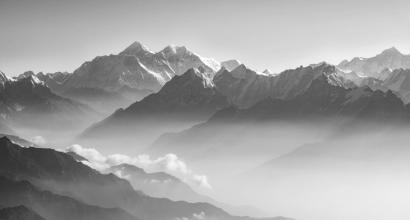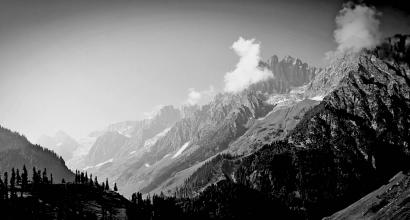The uniqueness of sanatana dharma is its universality. Three cardinal features confer upon it its universal character. These three are however not mutually exclusive; they, in fact, nourish one another.
1. The Natural Foundation
न वा अरे देवानां कामाय देवा: प्रिया: भवन्ति
आत्मनस्तु कामाय देवा: प्रिया: भवन्ति ।
न वा अरे वेदानां कामाय वेदा: प्रिया: भवन्ति
आत्मनस्तु कामाय वेदा: प्रिया: भवन्ति ।
"Not for the sake of the gods, my beloved, are the gods worshiped, but for the sake of the self. Not for the sake of the Vedas, my beloved, are the Vedas revered, but for the sake of the self". (Brihadaranyaka Upanishad)
This Vedic idea, trans-Vedic nevertheless, couched in those immortal love-talks of Yajnavalkya and Maitreyi, constitutes the very foundation of sanatana dharma. The self, which is "the same and yet not the same as the ego", is here the object of ultimate value. Therefore, the self, and not the world, becomes the determinant of all dharma. It is this feature that accounts for the naturnalness of sanatana dharma and makes its adherent amusingly independent of all societal constructs in the exercise of his religious choices. Vivekananda said it point-blank: "No two persons have the same mind or the same body...No two persons have the same religion." Multiplicity of Hindu Gods and myriad forms of their worship is a fierce expression of this primacy of self in the determination of dharma.
This primacy of the self requires and in fact, engenders a striking societal imperative – liberty. Naturalness expresses itself through liberty and liberty nurtures naturalness. All reformations within sanatana dharma have had this idea for their pivot. Vivekananda again: "Liberty is our natural right to be allowed to use our own body, intelligence, or wealth according to our will, without doing any harm to others...It is freedom in every way, i.e. advance towards Mukti is the worthiest gain of man. To advance towards freedom - physical, mental and spiritual - and help others to do so, is the supreme prize of man. Those social rules which stand in the way of the unfoldment of this freedom are injurious, and steps should be taken to destroy them speedily. Those institutions should be encouraged by which men advance in the path of freedom."
It may be mentioned in the passing that this principle stands at the root of the svakarma concept elaborated in the Bhagavad-Gita.
2. The Cultural Edifice
यद्यद्विभूतिमत् सत्त्वं श्रीमदूर्जितमेव वा।
तत्तदेवावगच्छ त्वं मम तेजोंऽश संभवम्।।
"All beautiful, glorious and mighty creations, springing as they do from a spark of my splendor, (are to thee objects of worshipful meditation)". (Bhagavad-Gita)
In this masterstroke of a verse, Krishna has universalized the culture of sanatana dharma. The ripe civilizational idea that aesthetic experience is a religious exercise, expressly stated in the verse quoted, has made art and religion the same thing in India. That our Gods and Goddesses, from Rama and Krishna to Hanuman and Draupadi, are characters from our literary classics is a most marvelous phenomenon of the Indian religion. Our temples doubling as auditoria for performing arts is a corollary of this phenomenon. The implications of this, needless to say, are enormous. The metamorphosis of religious instinct into aesthetic sensibility, of the egotistic into the universal, becomes here simply a matter of course.
The worship of Vibhuti, in addition to art experience, includes two other things: the celebration of natural geography (the great rivers, the great mountains etc. as centres of pilgrimage) and the worship of sages (from Vyasa-Vishvamitra to Ramana-Ramakrishna). While the former forges a sense of religious fellowship alongside promoting reverence for nature, the latter is a perennial renewer of faith in the grandest ideals of this Dharma.
3. The Scientific Robustness
न धर्मजिज्ञासायामिव ब्रह्मजिज्ञासायां श्रुत्यादय एव प्रमाणम्। किन्तु श्रुत्यादयो अनुभवादयश्च यथासंभवमिह प्रमाणम् अनुभवावसानत्वात् भूतवस्तुविषयत्वाच्च ब्रह्मज्ञानस्य।
"Examination of the nature of the self, though guided by scriptural authority, is quite independent of it. It derives its authority from being experiential as a matter of fact." (Brahmasutra Bhashya of Shankara)
"The question is: Is religion to justify itself by the discoveries of reason, through which every other science justifies itself? Are the same methods of investigation that we apply to sciences and knowledge outside, to be applied to science of religion? In my opinion this must be so...If a religion is destroyed by such investigations, it was then all the time useless, unworthy superstition, and the sooner it goes the better. I am thoroughly convinced that its destruction would be the best thing that could happen." (Vivekananda)
If there is one religion that can survive this rigorous examination, it is sanatana dharma. The avasthatraya prakriya of Vedanta, contained mainly in the Brihadaranyaka and Chandogya Upanishads, emphasized especially in the karikas of Gaudapada and clarified accessibly in the path-breaking work of Satchidanandendra Saraswati, is the truest exemplar of scientific robustness in the examination of ultimate reality (brahmajignyasa). Detailing the methodology is beyond the scope of this essay. Thanks to this Vedantic analysis, sanatana dharma is extricated from the web of beliefs and dogmas, which in spite of their benefits for the commoner, are unfulfilling to the intellectually robust. Solace comes from truth and from truth that is accessible.
These three together make sanatana dharma what it is – benign and accommodative, uplifting and joy-giving, strong and perennial.
सुखार्था: सर्वभूतानां
मता: सर्वा: प्रवृत्तय: ।
सुखं च न विना धर्मात्
तस्मात् धर्मपरो भवेत् ।।
"All beings are naturally driven by a quest after happiness. Unfailing happiness cannot be attained without righteous conduct. Therefore, righteous conduct is obligatory for all." (Vagbhata)
स्वकर्मण अनुष्ठानं
चिन्तनं परमात्मन: ।
रसनञ्च विभूतीनां
त्रयमेतद्धि सत्सुखम् ।।
"Work in consonance with one's natural proclivity, meditation upon the Self and worship of exalted beauty are the three sources of unfailing happiness." (Versification mine)



































